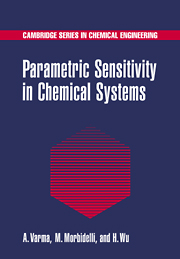Book contents
- Frontmatter
- Contents
- Preface
- 1 Introduction
- 2 Introduction to Sensitivity Analysis
- 3 Thermal Explosion in Batch Reactors
- 4 Runaway in Tubular Reactors
- 5 Parametric Sensitivity in Continuous-Flow Stirred Tank Reactors
- 6 Runaway in Fixed-Bed Catalytic Reactors
- 7 Parametric Sensitivity and Ignition Phenomena in Combustion Systems
- 8 Sensitivity Analysis in Mechanistic Study and Model Reduction
- 9 Sensitivity Analysis in Air Pollution
- 10 Sensitivity Analysis in Metabolic Processes
- Author Index
- Subject Index
5 - Parametric Sensitivity in Continuous-Flow Stirred Tank Reactors
Published online by Cambridge University Press: 04 May 2010
- Frontmatter
- Contents
- Preface
- 1 Introduction
- 2 Introduction to Sensitivity Analysis
- 3 Thermal Explosion in Batch Reactors
- 4 Runaway in Tubular Reactors
- 5 Parametric Sensitivity in Continuous-Flow Stirred Tank Reactors
- 6 Runaway in Fixed-Bed Catalytic Reactors
- 7 Parametric Sensitivity and Ignition Phenomena in Combustion Systems
- 8 Sensitivity Analysis in Mechanistic Study and Model Reduction
- 9 Sensitivity Analysis in Air Pollution
- 10 Sensitivity Analysis in Metabolic Processes
- Author Index
- Subject Index
Summary
Stirred vessels, with inlet and outlet fluid streams, are widely used as chemical reactors in practice. Their behavior can be approximated by an ideal model: the continuous-flow stirred tank reactor (CSTR), also called the perfectly mixed flow reactor, where temperature and concentration are uniform in the entire vessel and equal to those of the outlet stream. This device is particularly suited for processes where temperature and composition should be controlled and a significant amount of heat of reaction removed. Examples include nitration of aromatic hydrocarbons or glycerin, production of ethylene glycol, copolymerization of butadiene and styrene, polymerization of ethylene using a Ziegler catalyst, hydrogenation of α-methylstyrene to cumene, and air oxidation of cumene to acetone and phenol (Froment and Bischoff, 1990).
Although CSTRs are simple devices, they can exhibit a parametrically sensitive behavior when exothermic reactions are carried out. In this case, conversion and temperature in the reactor undergo large variations in response to small variations of one or more of the reactor operating conditions. Therefore, in practice, we need to determine operating conditions that avoid the parametrically sensitive region.
The parametric sensitivity behavior of CSTRs has been investigated only recently. The main reason is that in this case there is neither a temperature profile nor a hot spot, as in the case of batch or tubular reactors, so that all earlier parametric sensitivity criteria based on some geometric feature of these temperature profiles cannot be applied. It is only through the calculation of sensitivity of model outputs with respect to model inputs that the sensitivity behavior of such lumped systems can be investigated.
- Type
- Chapter
- Information
- Parametric Sensitivity in Chemical Systems , pp. 143 - 168Publisher: Cambridge University PressPrint publication year: 1999



